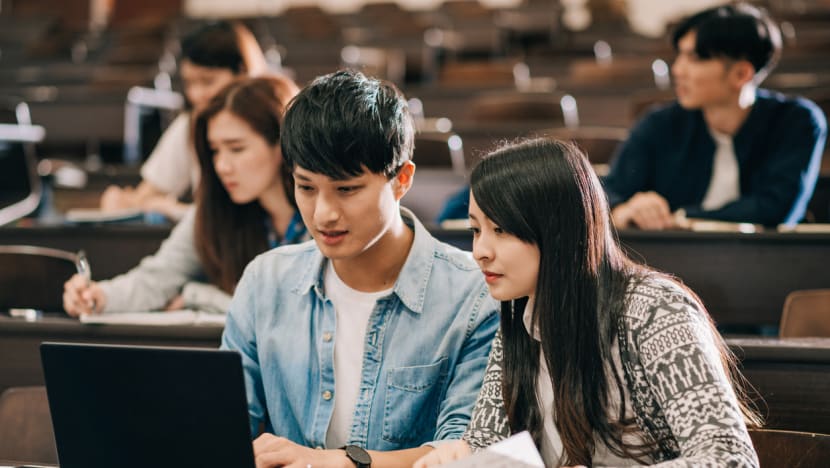Commentary: I am a teacher and I let my students use ChatGPT
NUS lecturer Jonathan Sim not only allows his students to use AI tools such as ChatGPT in his classroom, he actively encourages it.

File photo. Students have celebrated the arrival of AI tools like ChatGPT with excitement as they discover how useful it is to aid them in their learning. (Photo: iStock/Drazen_)
SINGAPORE: OpenAI’s ChatGPT, Google’s Bard, and very soon, Baidu’s Ernie. These artificial intelligence (AI) platforms are the first of many more to come. They have been sensational, and they are rapidly changing the way people learn and work.
In academia and education, reception to such AI platforms has stretched across a spectrum: Students celebrated its arrival with excitement as they discovered how useful it is to aid them in their learning, whereas the initial reaction from educators was concern over issues such as the originality of work and even cheating in exams.
This contrast led me to question: As educators, we often ask if our students are ready for the future, but how often do we ask ourselves if we educators are ready for the future?
While plagiarism and cheating are valid and important concerns, perhaps we educators are distracting ourselves from bigger issues: Do AI tools like ChatGPT really pose a risk to how much and how well students can learn and perform? And more importantly, do these same tools pose as much of a risk to us educators, on how well we can learn and adapt to effectively embrace the winds of change?
It is unrealistic for us to think that we can effectively nurture our students and prepare them to be ready for the future of work if we ourselves are unable to lead by example and adapt well to such technological changes. Especially when most, if not all of these AI platforms, will be here to stay and even evolve to become smarter and better over time.
For those of us who may be self-professed late adopters of technology - is now the time to catch up and keep up?
ENCOURAGE CHATGPT IN THE CLASSROOM
Singapore Education Minister Chan Chun Sing said in a parliamentary response on Feb 7 that AI tools like ChatGPT could be useful in the classroom when used appropriately.
I believe it is crucial for us to consult our students and work with them as co-creators, learning from their perspectives and experiences when designing new learning activities to prepare them for the future. In the education literature, this approach is known as “student-teacher collaboration”.
Over the weeks, I have been watching in amazement at how quickly my students have refined their AI prompting techniques to produce high-quality essays, generate very insightful questions, and answer multiple choice questions complete with a comprehensive elaboration on why it did or did not pick each option.
From this, I realised that students will continue to stay ahead of us because they have a more extensive social network to share their discovery of best ChatGPT practices with their peers.
As such, I have been collaborating with my students - the true experts of such AI platforms and stakeholders in their learning journey - and together we have been co-creating policies and learning activities to enhance their learning with these AI platforms.
With my students, we set out a policy to encourage responsible AI use by giving them a safe space to explore and learn with these AI platforms.
I make it clear that it is still plagiarism if they try to pass off AI-generated content as if it is their work. But, by allowing students to use AI-generated content with proper attribution and citations (just like how they cite materials sourced online), they feel empowered to be transparent and open about their use.
Such a policy will benefit everyone. Students will feel empowered to share their discovery of newer best practices more openly with others. They will be more forthcoming to share their AI-learning experiences with their teachers and to clarify doubts. And we educators can also gain valuable insights on how students use these AI platforms to design more relevant and effective learning activities in the future.
HERE’S YOUR NEW TUTOR. YOU CAN CALL HIM CHATGPT
And with the insights shared by my students, we were able to design two categories of learning activities to further enhance their learning with an AI.
First is for students to identify the limits of AI tools and find areas where human intervention will add value to the work. Students will generate a draft using ChatGPT, and they will be graded based on the comments they write about the draft, as well as their suggested improvements to the AI’s work.
The second approach is to treat the AI as a learning partner. The AI can play the role of a “tutor” by providing evaluative feedback on the quality of their work so that students can keep improving on it before the final submission. Or, the AI can play the role of a fellow “student”, with students conversing with it to gain new ideas or find out what they might have misunderstood to gain a better understanding. Regardless of the roles, the AI can provide students with useful instant feedback on what they do.
These learning activities will empower weaker students. By learning together with an AI, they can clarify basic concepts and get more questions answered without fear of judgment or embarrassment. The AI can help them to build confidence in their abilities as they can receive instant feedback on how they are doing at any time. This was never possible on a large scale with human educators.
DO WE STILL NEED HUMAN EDUCATORS?
Ultimately, these AI platforms will continue to transform the education landscape.
Fortunately for us, one thing will remain constant: Learning is a social activity.
Thus, our value as educators is to provide students with a platform to come together and share ideas and best practices with their peers - including how best to use AI tools. As educators, we can still add value to our students’ learning by challenging them to go further than an AI can, by encouraging them to explore more effective ways of working alongside it, and by teaching them to think critically and reflectively about responsible and impactful AI use in the works we produce.
We cannot do this alone. As educators, we must do this in collaboration with our students as partners and co-creators in this endeavour. If we do not embrace new ways of learning, new ideas, or new technologies with our students, we risk a disconnect with future generations.
Like it or not, technology will continue to advance and permeate into every aspect of our lives. If we want to make our classrooms mirror real life to prepare them for the future, we need to start embracing platforms like ChatGPT along with our students.
So, are we truly ready for the future?
Jonathan Sim is Lecturer, Department of Philosophy, Faculty of Arts and Social Sciences at the National University of Singapore.





















